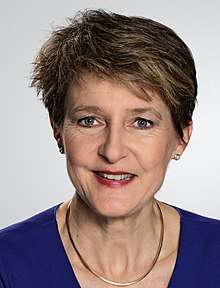President of the Swiss Confederation
The president of the Swiss Confederation, also known as the president of the Confederation or colloquially as the president of Switzerland, is the head of Switzerland's seven-member Federal Council, the country's executive branch. Elected by the Federal Assembly for one year, the officeholder chairs the meetings of the Federal Council and undertakes special representational duties.
| President of the Swiss Confederation
| |
|---|---|
.svg.png) | |
| Residence | Federal Palace |
| Term length | 1 year, not eligible for reelection immediately |
| Inaugural holder | Jonas Furrer |
| Formation | 21 November 1848 |
| Deputy | Vice President of the Federal Council |
| Salary | CHF 445,163, p.a. (Approx $448,000) as of 1 January 2017[1] |
| Website | Federal Presidency |
.svg.png) |
|---|
| This article is part of a series on the politics and government of Switzerland |
|
|
First among equals, the president of the Confederation has no powers over and above the other six councillors and continues to head the assigned department. Traditionally the duty rotates among the members in order of seniority; the vice president of the Federal Council assumes the presidency the year after the officeholder's tenure. The president of the Confederation is not the head of state because the entire Federal Council is the collective head of state.
The constitutional provisions relating to the organisation of the Federal Government and federal administration are set out in Section 1 Organisation and Procedure of Chapter 3 Federal Council and Federal Administration of the Title 5 Federal Authorities of the Swiss Federal Constitution[2] at articles 174 to 179. Article 176 specifically relates to the presidency.
Competencies
The Swiss president is not – as are, for example, the presidents in Austria or Germany – the head of state of the country: under the Swiss Federal Constitution, the Federal Council doubles as a collective head of state and head of government.[3] When a tied vote occurs in the council (which may happen, since on the one hand abstention is permitted, and on the other hand a meeting of the council can take place without all members present), his or her vote is worth double.[4]
In addition to the control of his or her own department, the president carries out some of the representative duties that are normally carried out by a single head of state in other democracies. For example, since joining the United Nations, Swiss presidents have on occasion spoken at inaugural sessions of the General Assembly along with other visiting heads of state and government.[5][6] However, because the Swiss have no single head of state, the country carries out no state visits. When traveling abroad, the president does so only in their capacity as head of their department. Visiting heads of state are received by the seven members of the Federal Council together, rather than by the president of the Confederation. Treaties are signed on behalf of the full council, with all Federal Council members signing letters of credence and other documents of the kind.
Election
The president is elected by the Federal Assembly from the Federal Council for a term of one year.[2][7][3]
In the nineteenth century, the election as federal president was an award for especially esteemed Federal Council members. However, a few less influential members of the government were regularly passed over. One such example was Wilhelm Matthias Naeff, who – although a member of the Federal Council for 27 years – was federal president only once, in 1853.
Since the twentieth century, the election has usually not been disputed. There is an unwritten rule that the member of the Federal Council who has not been federal president the longest becomes President. Therefore, every Federal Council member gets a turn at least once every seven years. The only question in the elections that provides some tension is the question of how many votes the person who is to be elected president receives. This is seen as a popularity test. In the 1970s and 1980s, 200 votes (of 246 possible) was seen as an excellent result, but in the current era of growing party-political conflicts, 180 votes are a respectable outcome.
Until 1920, it was customary for the serving federal president to also lead the Department of Foreign Affairs. Therefore, every year there was a moving around of posts, as the retiring president returned to his former department and the new president took up the foreign affairs portfolio. Likewise, it was traditional for the federal president not to leave Switzerland during their year in office.
References
- "How much does a federal councillor earn?" (official site). Berne, Switzerland: The Federal Council. 24 April 2017. Retrieved 17 May 2018.
- "SR 101 Federal constitution of the Swiss Confederation of 18 April 1999 (Status as of 12 February 2017), unauthorized English version" (official site) (in German, French, Italian, and English). Berne, Switzerland: The Federal Council. 12 February 2017. Retrieved 23 March 2018.
- Stojanović, Nenad (1 March 2016). "Party, Regional and Linguistic Proportionality Under Majoritarian Rules: Swiss Federal Council Elections". Swiss Political Science Review. Geneva, Switzerland: Swiss Political Science Association. 22 (1): 41–58. doi:10.1111/spsr.12208. ISSN 1662-6370.
- Government and Administration Organisation Act, Art. 19.
- Hug, Simon; Wegmann, Simone (1 June 2013). "Ten Years in the United Nations: Where Does Switzerland Stand?". Swiss Political Science Review. Geneva, Switzerland: Swiss Political Science Association. 19 (2): 212–232. doi:10.1111/spsr.12034. ISSN 1662-6370.
- "UN News - Swiss President, at General Assembly, Highlights Crucial Role of UN in Solving Crises" (Press release). New York City: UN News, United Nations. 20 September 2016.
- Emerson, Peter (2012). Defining Democracy: Voting Procedures in Decision-Making, Elections and Governance (2nd ed.). Berlin, Germany: Springer-Verlag. pp. 125–126. ISBN 978-3-642-20904-8.
External links
- Official website

- Leonhard Neidhart: President of the Confederation in German, French and Italian in the online Historical Dictionary of Switzerland, 2010-08-02.

